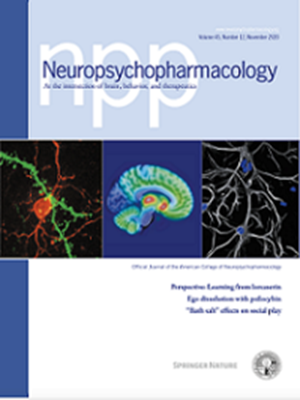Childhood family environment and μ-opioid receptor availability in vivo in adulthood
IF 6.6
1区 医学
Q1 NEUROSCIENCES
引用次数: 0
Abstract
Animal studies have reported associations of early maternal separation with altered μ-opioid receptor function but data on humans are scarce. We now investigated whether childhood family environment is related to μ-opioid receptor availability in the human brain in adulthood. Healthy participants (n = 37–39 in the analyses) were recruited from the prospective population-based Young Finns Study (YFS) that started in 1980. Childhood family environment was evaluated in 1980, including scores for stress-prone life events, disadvantageous emotional family atmosphere, and adverse socioeconomic environment. We used positron emission tomography (PET) with radioligand [11C]carfentanil to measure μ–opioid receptor availability in adulthood. Age- and sex-adjusted analyses showed that exposure to stress-prone life events in childhood was related to lower μ-opioid receptor binding in the orbitofrontal cortex, hippocampus, putamen, amygdala, insula, thalamus, anterior cingulate cortex, and dorsal caudate in adulthood (when compared to participants not exposed to stress-prone life events). Unfavorable socioeconomic family environment or disadvantageous emotional family atmosphere was not associated with μ-opioid receptor availability in adulthood. In conclusion, exposure to environmental instability (i.e., to stress-prone life events below traumatic threshold) during early development is associated with dysregulation of the u-opioid receptor transmission in adulthood. The findings increase understanding of the neurobiological mechanisms involved in the associations between childhood adversities and adulthood mental disorders.

童年家庭环境和成年后体内μ-阿片受体的可用性。
动物研究已经报道了母体早期分离与μ-阿片受体功能改变的关联,但人类的数据很少。我们现在研究童年家庭环境是否与成年后人脑中μ-阿片受体的可用性有关。健康参与者(n = 37-39)是从1980年开始的前瞻性人群为基础的年轻芬兰人研究(YFS)中招募的。1980年对童年家庭环境进行了评估,包括易产生压力的生活事件、不利的情感家庭氛围和不利的社会经济环境得分。我们使用带有放射性配体[11C]卡芬太尼的正电子发射断层扫描(PET)来测量成人μ-阿片受体的可用性。年龄和性别调整分析表明,童年时期暴露于压力易发生活事件与成年期眶额皮质、海马、壳核、杏仁核、脑岛、丘脑、前扣带皮层和尾状背的α -阿片受体结合水平较低有关(与未暴露于压力易发生活事件的参与者相比)。不利的社会经济家庭环境或不利的情感家庭氛围与成年期μ-阿片受体可用性无关。总之,在发育早期暴露于环境不稳定(即低于创伤阈值的压力易发生活事件)与成年期u-阿片受体传递失调有关。这些发现增加了对童年逆境和成年精神障碍之间关联的神经生物学机制的理解。
本文章由计算机程序翻译,如有差异,请以英文原文为准。
求助全文
约1分钟内获得全文
求助全文
来源期刊

Neuropsychopharmacology
医学-精神病学
CiteScore
15.00
自引率
2.60%
发文量
240
审稿时长
2 months
期刊介绍:
Neuropsychopharmacology is a reputable international scientific journal that serves as the official publication of the American College of Neuropsychopharmacology (ACNP). The journal's primary focus is on research that enhances our knowledge of the brain and behavior, with a particular emphasis on the molecular, cellular, physiological, and psychological aspects of substances that affect the central nervous system (CNS). It also aims to identify new molecular targets for the development of future drugs.
The journal prioritizes original research reports, but it also welcomes mini-reviews and perspectives, which are often solicited by the editorial office. These types of articles provide valuable insights and syntheses of current research trends and future directions in the field of neuroscience and pharmacology.
 求助内容:
求助内容: 应助结果提醒方式:
应助结果提醒方式:


